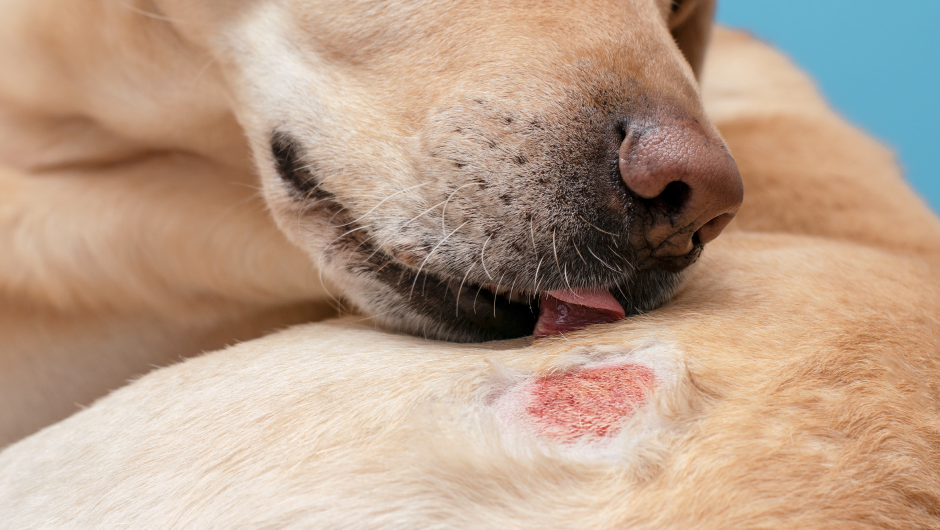Hair loss in pets can have many causes.
It can present as areas of thinning hair or outright bald spots that are very noticeable. An examination by a veterinarian is needed to determine which of the many causes is to blame and to begin proper treatment for hair loss in pets in order to resolve the problem. Living in Florida, we are all familiar with allergies and how they can cause skin problems. Today, I will discuss a less frequent, but still common cause of hair loss: mange mites.
Sarcoptic mange mites or ‘red mange’
There are two common and very different types of mange mites and both cause hair loss. The one that most people think of when they hear the word mange is the sarcoptic mange mite, also known as “red mange.” The condition has earned this name because the intense itching it causes results in hair loss and red skin from constant scratching. Sarcoptic mange is perhaps best known because is very contagious, even among people. For the purposes of this article, however, I will focus the discussion on how this type of mange affects dogs and cats.
Fortunately, sarcoptic mange is easily treated, and the mites are very susceptible to several different treatments. There are special dips that existed as the only type of treatment for many years, and they are still effective. They do have side effects that are of special concern in young puppies, and some of the treatments can be deadly if given to cats. They are not used as much anymore because of a newer medicine that was originally used in cattle that kills mites quickly with just a couple of injections. In addition, there is a topically applied medication that is in the same family as the injection, which works, in some cases, with just a couple of applications. Sometimes antibiotics are needed to clear up secondary bacterial infections caused by all the scratching, but that is easily accomplished, as well.
Demodectic mange mites
A second type of mange mite that is more insidious is the demodectic mange mite. Most-if not all- dogs acquire this mite from their mothers at birth. These mites live deep in the skin of dogs in a dormant stage the entire life of the pet. The demodectic mite is predominately seen in dogs, although it is diagnosed on rare occasions in cats, too. It is insidious because it causes hair loss very slowly and without any itching to alert the pet owner that there is an issue.
Fortunately, it only becomes active and causes a problem in stressed animals or those with weakened immune systems. It is mostly seen in young, growing puppies and then, in only a small percentage. Growth and especially rapid growth stress the body, and if a puppy also is stressed for other reasons, such as poor diet, an illness, bullying, and/or moving to a new home, that can give the mite the opening it needs to become active.
What are the symptoms?
Infection by the demodectic mite is usually first seen as a small patch of thinning hair that grows larger over a period of days. It may be in only one or two places, or it may spread to multiple areas over the entire body. Left untreated, it will eventually cause all of the hair to fall out, and the skin will darken and succumb to secondary bacterial infections. This happens to a very small number of dogs with compromised immune systems and, as a result, will require monitoring and treatment their entire lives. Fortunately, most puppies and even older dogs who have slightly weakened immune systems respond well to treatment, and the condition never advances to what is known as generalized demodicosis.
How is demodectic mange treated?
Because the mite is so deep in the skin and advances slowly, it takes several months of treatment before it returns to the dormant stage. Treatments include weekly topical dips, daily oral medications and my personal favorite, weekly injections. Each of the two most common oral medications have drawbacks. One is very expensive and the other, while quite reasonably priced, is dangerous to administer. It is made for cattle that weigh upwards of a thousand pounds, and to dose for a tiny puppy or even an adult dog is dangerous with a razor-thin margin of error. The injection is similar, but is given by a veterinarian in a clinic setting once a week, which is much safer.
Since puppies are seen by a veterinarian every few weeks for the first few months of their life, demodectic mange mites are generally diagnosed early and respond well to treatment. If your pet is experiencing hair loss, please make an appointment with your veterinarian to have it checked out as soon as possible.

